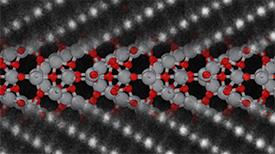

06/28/2021

© 2021 Yuichi Ikuhara & Chris J. Pickard
A collaboration between AIMR, the University of Tokyo, the University of York, and the University of Cambridge has demonstrated a new approach to investigating grain-boundary structures1. Combining scanning transmission electron microscopy (STEM) with ab initio random structure searching (AIRSS), the team has isolated a grain boundary with strong anatase character embedded in bulk rutile TiO2, taking one more step toward bridging the structure-property gap in ceramics research.
Grain boundaries are ideal platforms for tailoring ceramic materials such as TiO2. Ubiquitous in all but single-crystal solids, these interfacial structures are believed to be the sites of many processes such as dopant segregation, charge recombination, and domain migration—all potential solutions to engineering desired macroscopic properties of bulk materials.
However, while the traditional approach involving high-resolution imaging followed by computational optimization can elucidate simple grain-boundary structures, it cannot address more complex interfacial structures—where interesting physics happens—due to the 2D image limitations.
Here, the team led by Yuichi Ikuhara and Chris Pickard from AIMR, and Keith McKenna from the University of York takes a synergistic approach to broaden the scope of the grain-boundary structure investigation. Starting with imaging the grain boundary of a rutile TiO2 bicrystal with high-resolution STEM, the team then uses AIRSS to explore the chemical environment adjacent to the imaged 2D structure.
“Our initial local energy minimization methods failed to find a structure consistent with experimental STEM and electron energy-loss spectroscopy (EELS) observations,” says McKenna. “Hence, we applied AIRSS, a global optimization method, to uncover the structure of the more complex TiO2 grain-boundary structure.”
This way, the team has predicted the local chemical environment of the imaged grain-boundary structure, calculated its EELS signals, and confirmed these signals experimentally. The results demonstrate that the grain boundary of the imaged bicrystal strongly resembles bulk anatase TiO2—an impossible feat using the traditional modeling approach.
“Our study shows that the structures of complex interface systems are now within reach,” says Georg Schusteritsch from the University of Cambridge. “We will use our method not only to elucidate these structures, but also to calculate their electronic, thermal, and mechanical properties for future interface designs.”
(Author: Patrick Han)
This research highlight has been approved by the authors of the original article and all information and data contained within has been provided by said authors.